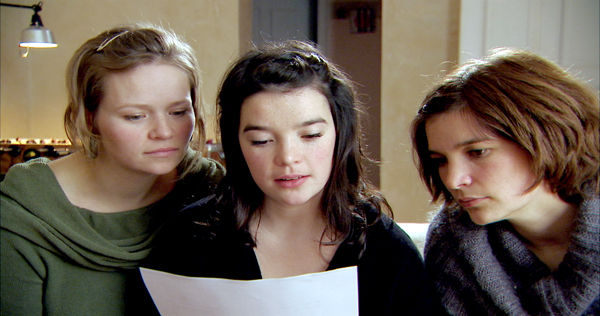|
Reviews of Recent Independent, Foreign, & Documentary Films in Theaters and DVD/Home Video

HARLAN:
IN THE SHADOW OF JEW SÜSS
In the documentary Harlan: In the Shadow of Jew Süss, director Felix Moeller provides multi-faceted context for that notorious film, with fascinating details on Harlan’s life and oeuvre, and the complex and lasting impact of his work and ignominy on his extended family. The audience is immediately plunged into the controversy by following Harlan’s pan-European grandchildren on a tour of Stuttgart’s Baden-Wuerttemberg history museum exhibit on the film. (Stuttgart is where the real Joseph Suess Oppenheimer was executed on trumped-up charges in 1738, inspiring a novel and play that were the basis for the highly fictionalized film.) More excerpts of the stereotyped tale of a powerful moneylender lusting after a fair German maiden can be seen in this documentary than in U.S. museums. In an informative film history of German movie-making during the rise and dominance of the Nazis, the rare clips from many hit Harlan films are particularly vital to see why Goebbels favored him, or forced him to work as Harlan subsequently claimed. Goebbels was a populist, determined to reach as wide an audience as possible. He admired German-born William Wyler’s 1942 Mrs. Miniver as the most effective propaganda film made during the war. Harlan’s series of popular melodramas starring his third wife, the Swedish Kristina Söderbaum, portrayed the ideal Aryan beauty tragically besieged by evil-doers. (Similarly, Hitler singled-out Leni Riefenstahl because of her sentimental mountain films celebrating rural German values, but Goebbels didn’t control her work.) The irony is how similar his Reich-sponsored films are to his earlier ones, just with bigger budgets. This helped his successful defense against charges as a “fellow traveler” in two post-war trials before he retired to sunny Capri in the 1960’s. A centerpiece is Harlan’s final, stirring 1945 film for the Reich, Kolberg, which inspired the concept for Inglourious Basterds’ film-within-a-film, Stolz Der Nation. Most startling is a TV interview with Harlan describing his arguments with Goebbels, who rejected scenes of wartime heroism in this huge epic recreation of Napoleon’s army defeat as “too sadistic.” (Harlan seemed to regret the waste of money from shooting the complicated scenes more than anything else.) If you think that situation could have come out of a biting Stanley Kubrick anti-war satire, that director probably thought so too. Kubrick married Harlan’s niece Christiane, and she recalls her husband meeting with Kristina Söderbaum and Maximilian Schell to reenact for a possible film what a production meeting would have been like with Goebbels as the Ultimate Suit. Beyond the film history, the last part examines how Harlan’s descendants deal with the difficulty of his legacy. In the early, confusing interviews, they are only identified by first name, then later by generation (Harlan’s five children by two of his wives and eight grandchildren). Several felt so guilty that they married Jews, including a daughter who converted and raised her children Jewish. (Harlan’s brief first marriage was to a Jew who later died in Auschwitz.) Others sought expiation through political activism, from anti-Fascist activities to anti-nuclear protests.
Viewing this thought-provoking film can’t help but raise
questions for Americans. D. W. Griffith’s The Birth of a Nation
from 1915 left a bloody trail of brutal attacks against African
Americans and led directly to the resurgence of the Ku Klux Klan,
stoking emotions that his Intolerance couldn’t tamper. Griffith
lived just long enough that he could have been aware of
Jew Süss,
and one wonders what he and his family thought of the
parallels. Will Americans undertake this frank an introspection if
Disney ever rereleases the 1946 Song of the South and CBS the TV
series
Amos and Andy from their vaults?
Nora Lee Mandel
|

